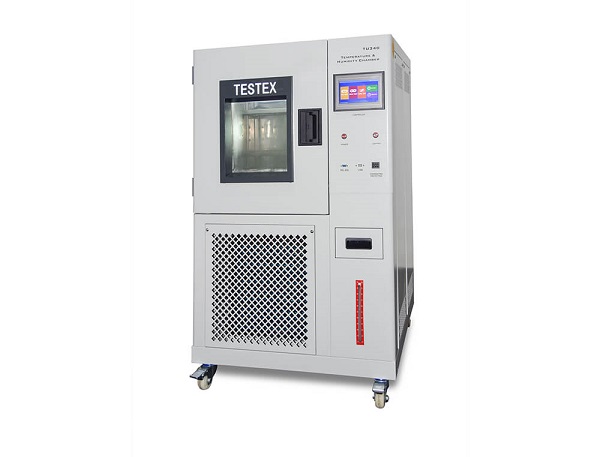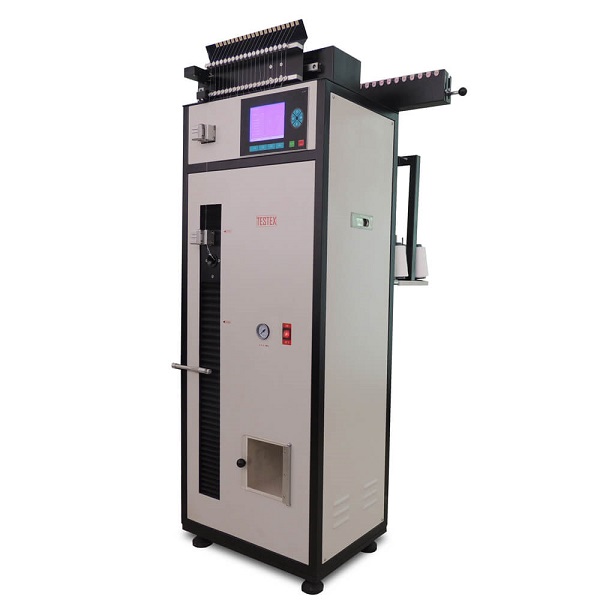What is water vapour permeability? The water vapour permeability test measures how well fabrics let…
Analysis of the Effect of Temperature and Humidity on Textile Property Testing
Temperature and humidity have an obvious influence on the characteristics and properties of textile fibers. Under different temperature and humidity conditions, textile test items, such as breaking strength, uniformity of strips, thread density, pilling, static electricity, etc. will show different test results.
In order to ensure the validity of the test data, facilitate data statistics and analysis, and promote the smooth conduct of both sides of the textile trade, ISO has developed ISO 139 “Standard Atmosphere for Conditioning and Testing of Textiles” This article takes cotton fibres as an example and briefly analyses the influence of temperature and humidity on textile property testing.
Reference standard: ISO 139, Textiles – Standard atmospheres for conditioning and testing
Keywords: temperature and relative humidity, standard atmosphere, specific standard atmosphere, tropical standard atmosphere, conformity assessment
Table of Contents
- ★ The relationship between the characteristics of cotton fibre and temperature and humidity
- 1 Effect of temperature and RH on the moisture absorption of cotton fibers
- 2 The effect of temperature and relative humidity on the strength of cotton fibres
- 3 The effect of temperature and relative humidity on the elongation and softness of cotton fibres
- 4 The effect of temperature and relative humidity on the electroconductibility of cotton fibers
- ★ Temperature and humidity of the standard atmosphere
- ★ Test comparison of standard atmosphere and tropical standard atmosphere
- ★ Specific standard atmospheres for temperature and humidity
★ The relationship between the characteristics of cotton fibre and temperature and humidity
1 Effect of temperature and RH on the moisture absorption of cotton fibers
Cotton fibers have good moisture absorption, due to the different maturity of cotton fibres, the size and amount of fibre curl varies, the moisture absorption varies. As the relative humidity of the environment increases, the moisture absorption of the fibres will increase. In the case of constant relative humidity, the moisture absorption of the fibres will decrease as the temperature increases.
2 The effect of temperature and relative humidity on the strength of cotton fibres
Temperature and relative humidity affect the strength of cotton fibres, especially the relative humidity has a significant effect on the strength of cotton fibres. When the relative humidity of cotton fibres are in the range of 44% to 70%, the strength of the fibres changes more significantly with the increase in relative humidity.
3 The effect of temperature and relative humidity on the elongation and softness of cotton fibres
When cotton fibres are subjected to the tensile action of external forces, a corresponding elongation deformation occurs. After moisture absorption, the elongation of the fibres increases as the distance between the fibre molecules increases, resulting in relative displacement, so that the relative humidity increases, the softness of the fibres increases, the hardness and brittleness decrease and the plasticity decreases. The effect of temperature on fibre elongation is less.
4 The effect of temperature and relative humidity on the electroconductibility of cotton fibers
Cotton fibres are poor electroconductibility, in the textile processing, fibres and mechanical surface friction and electrostatic effect. Fibres and machinery with different electrical charges will attract each other and make fibres adsorbed on the surface of the machine, destroying the running rules of fibres and preventing the normal carding, drafting, winding and twisting of fibres, thus affecting the quality of the yarn. In order to reduce the negative effects of static electricity on fibre processing, the relative humidity can be increased to increase the electrical conductivity of the textile fibres, and the charge is not easy to accumulate and static electricity is reduced.
The effect of temperature on the electrical conductivity of textile fibres, which generally increases as the temperature rises, however, when the temperature is too high, it affects the moisture absorption of the fibres and thus reduces the electroconductibility of the textile fibres.
★ Temperature and humidity of the standard atmosphere
Temperature and humidity have a marked effect on cotton textile testing and therefore a standard atmosphere is specified in cotton textile testing. There are two ways in cotton textile testing standards.
1 Without reference to ISO 139, the temperature and humidity conditions are specified separately in the corresponding articles of the standard, e.g. FZ/T 20017 “Testing Method of Woolen Yarn”, 3.1 Standard atmosphere for conditioning and testing, temperature (20.0±2.0)℃, relative humidity (65.0±4.0)%; atmosphere for pre-conditioning, temperature not exceeding 50.0 ℃, relative humidity 10.0%~25.0%.
2 ISO 139 is referenced in the normative references, and there are three atmospheric conditions in the standard ISO 139, as follows
| Standard atmosphere | 20.0℃, 65.0% | Tolerance for temperature: ±2℃
Tolerance for RH: ±4.0% |
| Specific standard atmosphere | 23.0℃, 50.0% | |
| Tropical standard atmosphere | 27.0℃, 65.0% |
The relevant citation standards are listed below
| Standard No. | Name | Reference |
| ISO 2061 | Textile – determination of twist in yarns – direct counting method | Pre-conditioning, conditioning and testing in accordance with ISO 139 |
| ISO 2062 | Textile – yarns from packages – determination of single-end breaking force and elongation at break using constant rate of extension (CRE) tester | Pre-conditioning, conditioning and testing in accordance with ISO 139 |
| GB/T 4802.1 | Textile – determination of fabric propensity to surface fuzzing and to pilling – part 1: circular locus method | Conditioning and testing in accordance with ISO 139 |
| ISO 5077 | textile – determination of dimensional change in washing and drying | Conditioning and testing in accordance with ISO 139 |
| ISO 105-A01 | Textile – Tests for colour fastness – Part A01: General principles of testing | Pre-conditioning, conditioning and testing in accordance with ISO 139 |
| Note: There are many other methodological standards, some of which are not listed here. | ||
★ Test comparison of standard atmosphere and tropical standard atmosphere
1 Sample comparison
In order to exclude the influence of different tube yarns on the test analysis, a rotor spun cylinder yarn (COE 29.2tex) with good quality stability was selected for the test. In order to facilitate an accurate analysis and to exclude the influence of the discrete quality of the sample itself on the test, the single yarn breaking strength was repeated 99 times. In order to be able to fully validate this, the same sample was tested 5 times at different temperature and humidity intervals.
2 Temperature and relative humidity control
Standard atmosphere 20℃, 65% RH; Tropical standard atmosphere 27℃, 65% RH. Allowable tolerance zone: temperature is ±2.0℃, relative humidity is ±4.0%, temperature and humidity chamber can be used for rapid conditioning of the specimen.

3 Implementing standards
ISO 2062 “Textile – yarns from packages – determination of single-end breaking force and elongation at break using constant rate of extension (CRE) tester”.
4 Testing instrument

5 Test results
The results of the COE 29.2tex tests at different temperatures and relative humidity are shown in the table below.
| Temperature and RH | Single yarn breaking strength /cN | Coefficient of dispersion /% |
| 20.0℃, 65% | 214.1 | 10.7 |
| 214.8 | 8.2 | |
| 216.1 | 8.3 | |
| 215.6 | 10.1 | |
| 213.0 | 10.1 | |
| 27.0℃, 65% | 220.4 | 8.7 |
| 218.5 | 10.2 | |
| 219.5 | 8.2 | |
| 219.3 | 11.1 | |
| 217.4 | 9.23 |
★ Specific standard atmospheres for temperature and humidity
Some textile test items, either for the accuracy of the test results or for the operability of the test, are not suitable for standard atmospheres, so special temperatures and relative humidity are used, which given in ISO 139: 23.0℃, 50.0% RH.
In textile testing, temperature and relative humidity are available in addition to 23.0℃, 50.0% RH. For example, in the standard EN 1149-1 “Clothing – electrostatic properties – test method for measurement of surface resistivity”, the temperature is (23±1)℃ and the relative humidity is (25±5)%
In addition, in the actual process of textiles testing, in addition to the above specific standard atmospheres, there are a variety of temperature and humidity requirements, as follows:
temperature (20±2)℃, relative humidity (35±5)%
temperature (23±1)℃, relative humidity (25±5)%
temperature (23±2)℃, relative humidity 45%~55%
In summary: uniform test temperature and relative humidity is an important condition for the validity of test data for textile physical test items. The standard atmosphere and tropical standard atmosphere in ISO 139 as different temperature and humidity conditions will therefore produce different test results and may even affect the validity of the conformity assessment of testing, therefore the humidity regulation conditions and environment of the test should be indicated in the test report.




This Post Has 0 Comments